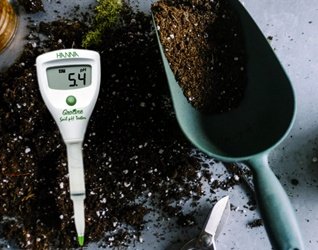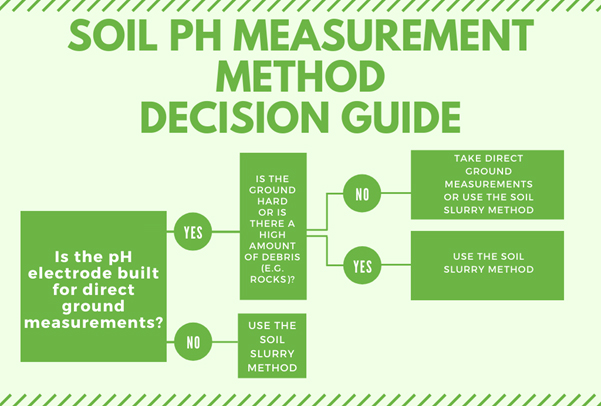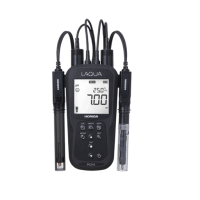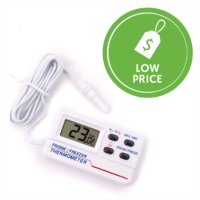How Do I Test My Soil pH?

In this article, Instrument Choice reviews the two main methods of determining soil pH using a soil pH tester, while outlining how you select the measurement method that best suits your pH meter and the ground composition of the soil you wish to test.
About Soil pH
The ideal soil pH range for most plants falls somewhere between pH 5.5 and 7.5, although there are plenty of plant species that thrive outside of this range, so always check the ideal range for the plants you wish to grow.
Soil pH is a vital parameter to monitor as pH affects plant growth and development.When your soil pH is out of the ideal range, the nutrient uptake of your plants and crops will be compromised, and therefore they may not reach their full growth potential.
Several factors affect soil pH:
- Weather
- Type and application of fertiliser
- Type and amount of irrigation
- Soil type; and
- Other plants in the area.
All these external influences mean the pH of your soil can change often and significantly. The potential for this variation and the associated impact on your plant's wellbeing underlines why you need to take regular measurements of your plant's soil using a soil pH tester.
Soil Testing Methods
There are two primary methods for testing soil pH:
- Direct ground measurement; and
- Measurement with a soil slurry using a 2:1 method.
The testing method employed will depend on your soil pH tester electrode and the soil/ground composition. To assist in your decision making, we have created a "Soil pH Measurement Method Decision Guide" (below).

Figure 1 The Instrument Choice Soil PH Measurement Method Decision Guide.
1. Direct Ground Method
The direct ground measurement is helpful as it can be performed in situ, resulting in faster soil pH measurements. The downside of this method is the risk of damaging your pH tester electrode. To perform a direct ground measurement you will need;
I. Soil pH tester with electrode
II. Shovel or auger III. Tap water
IV. Distilled Water
V.Gloves (Recommended)
-
- If there are no rocks, stones or debris present, use the shovel to dig and discard approximately 5cm of topsoil.
- Perforate the soil using a shovel to the depth you would like to determine the pH. If the soil is extra dry, moisten with a small amount of distilled water.
- Rinse the calibrated electrode with tap water.
- Slowly press the electrode into the soil. Do not force as this could risk damaging the electrode.
- Wait for reading to settle and observe the measurement.
- Once finished, wash the electrode in tap water and gently remove any remaining soil using your fingers. Try and avoid using a cloth as this could damage the electrode.
- Repeat procedure in several locations for your sample. For best results consider the average of the measured data
Video: How to Take a Direct Soil pH Measurement using the IC-HI981030 Groline Soil pH Tester
2. Soil Slurry Method
The soil slurry method is slightly more time consuming than direct ground measurement; however, it will prolong the life of your soil pH tester electrode and will generally produce more accurate results. To measure soil pH using a soil slurry you will need;
I. Soil pH tester with an electrode
II. Shovel or auger
III. Ziplock bags
IV. Deionised water
V. 250ml Beaker or Cup
VI. 2mm Sieve
VII.Gloves (Recommended)
-
- Dig and discard the first 5cm of topsoil.
- Perforate the soil using a shovel to the depth you would like to measure the pH.
- Collect samples from the perforated ground, if performing multiple samples (as recommended) take the same quantity of soil for each sample.
- Mix all the collected samples to create a composite. Discard any sticks, rocks, or foreign matter from this mix.
- Sieve the mixed soil sample on a 2mm screen and discard any overs.
- Weigh 25 grams of the sieved soil and measure 50ml of deionised water. Mix for 30 seconds.
- Let the slurry rest for a minimum of 5 minutes.
- Mix again then insert the electrode into the solution for your measurement.
Video: How to Prepare a Soil Slurry for pH Measurement
Conclusion
Soil pH testers are the simple-to-use 'key' to unlocking your plant's full growth potential. Both methods of soil pH measurement produce accurate results. However, in some conditions, there is a risk of damaging the electrode of certain pH testers. To ensure you protect your equipment, our team of Instrument Choice Scientists recommends you apply the decision process set out in the"Soil pH Measurement Method Decision Guide" (Figure 1 above) to determine which method is right for your conditions.
After some further tips to ensure accurate soil pH measurements using your soil pH tester? Read the Instrument Choice article 'Four tips for accurate measurements with your soil pH tester.'
If you are unsure which method to choose or would like a hand finding the best soil pH tester for your needs, Speak to an Instrument Choice Scientist, we're here to help! Call 1300 737 871 or email [email protected].
Also interesting
HORIBA manufactures an extensive range of scientific equipment. They have an excellent reputation for their water quality testing meters. Instrument Choice stocks Horiba, along with other selected brands, to ensure our clients can measure anything and measure everything to do with water quality - test us out!
If you are concerned about monitoring water quality, we invite you to become familiar with Horiba water testing instruments if your business, profession, or department needs quality, reliable, and accurate equipment.

Monitoring fridges and freezers to ensure they are keeping a stable temperature is a critical factor in many environments. Some example applications include food production facilities, pharmaceutical refrigerators, or even within the home. Fridge thermometers are small, yet indispensable devices vital to ensuring food and vaccine safety.
Playing such a significant role, your choice of fridge thermometer is an important task. To help you choose the best fridge thermometer for your needs, Instrument Choice scientists have assembled a list of key terms, definitions and features you should consider when comparing fridge thermometers and their specification sheets.

